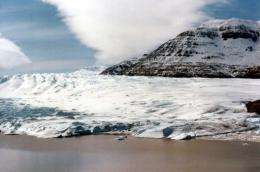Massive glacier in sub-Antarctic island shrinks by a fifth

One of the biggest glaciers in the southern hemisphere shrivelled by a fifth in 40 years, French scientists said on Wednesday.
The Cook glacier on Kerguelen, an island in France's southern Indian Ocean territories, covered 501 square kilometres (193 square miles) in 1963.
Combining satellite images with other data, glaciologists from the Laboratory for Studying Geophysics and Space Oceanography estimate the glacier lost an average of nearly 1.5 metres (4.9 feet) in height each year by 2003, shedding almost 22 percent of its original volume.
In terms of area, the glacier shrank by 1.9 sq. kms. (0.74 sq. miles) per year from 1963 to 1991.
Thereafter the loss doubled, to 3.8 sq. kms (1.48 sq. miles) per year. By 2003, the glacier covered only 403 sq. kms (155 sq. miles), a retreat of 20 percent compared with 1963.
The study has been accepted by a US publication, the Journal of Geophysical Research.
It says Cook's early shrinkage could be attributed in part to the residual effect of natural warming that ocurred after the "Little Ice Age" that ended in the late 19th century.
But the post-1991 warming is linked more to higher temperatures and low precipitation that began to occur in the early 1980s.
This is also a period when man-made carbon emissions started to soar and the Southern Ocean that girdles Antarctica showed perceptible warming.
Other studies in Patagonia, South Georgia and Heard Island have also suggested that warmer seas are leading to "strong and accelerated wastage" of glaciers on the fringes of Antarctica, the paper says.
(c) 2009 AFP

















